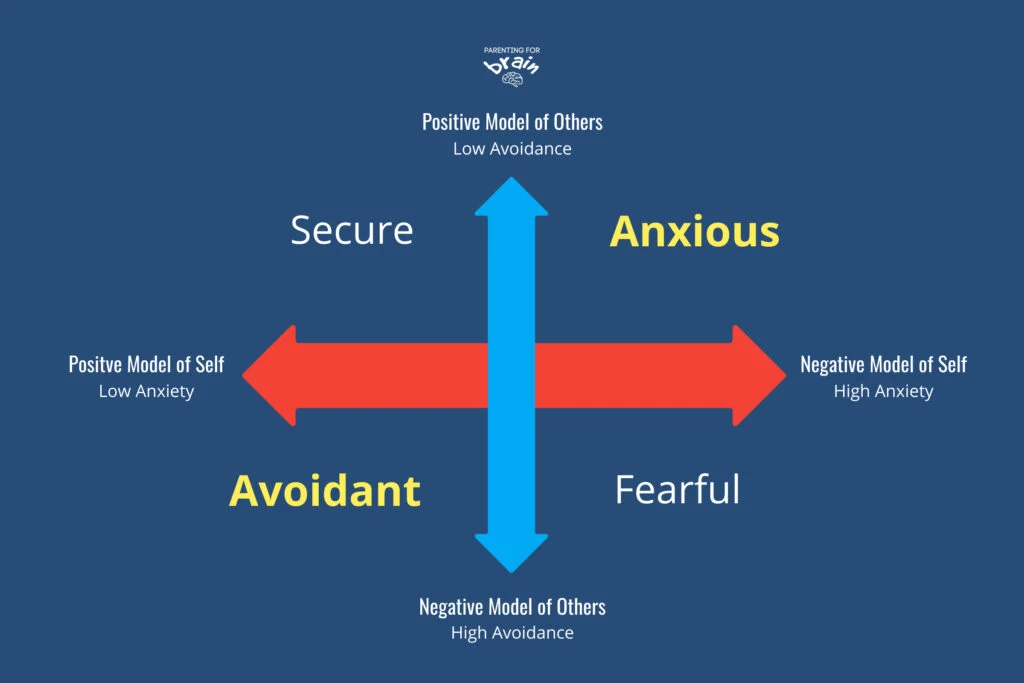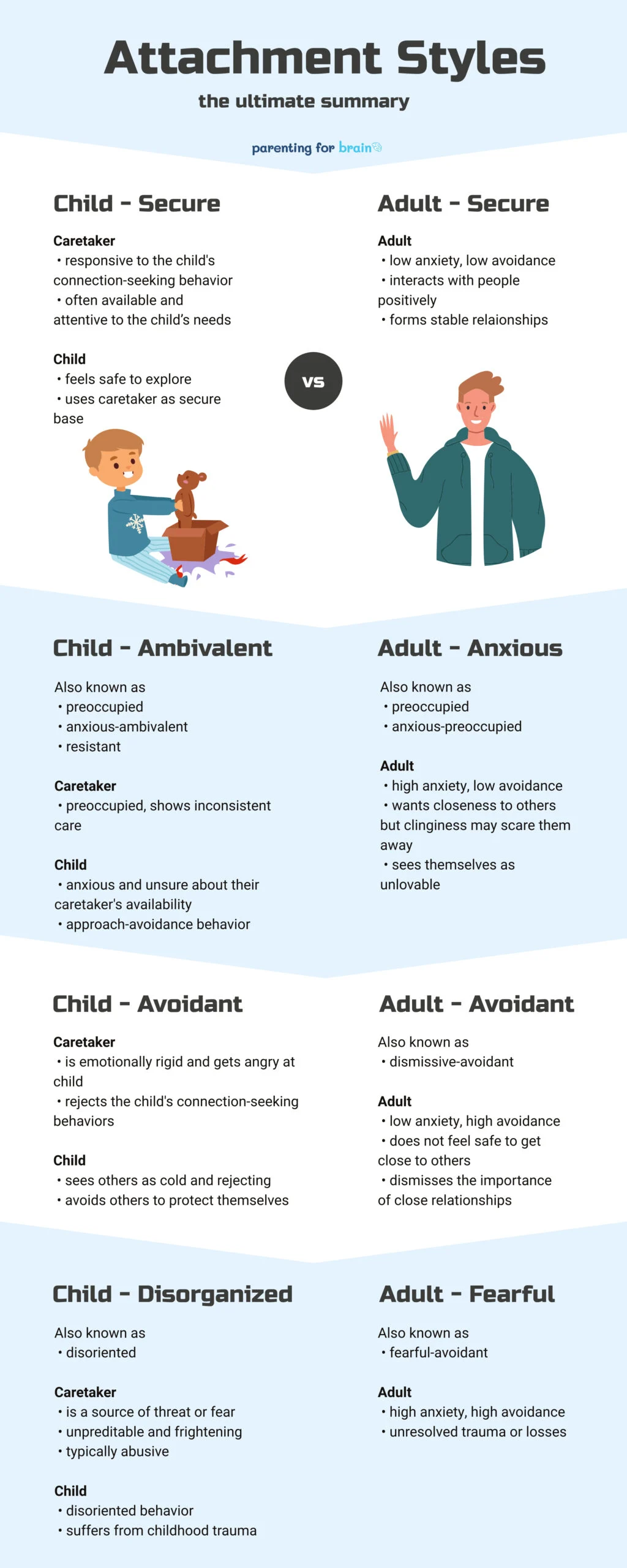- What is anxious avoidant attachment style
- Attachment theory overview
- Attachment styles
- Two-dimensional model
- Causes
TABLE OF CONTENTS
What is anxious avoidant attachment
While the term anxious-avoidant attachment style is often seen nowadays, it did not exist in the early days of attachment studies.
Attachment style names can be confusing.
There are often inconsistencies in how researchers call them.
Categorizing them using a two-dimensional model makes it easier to understand.
The attachment anxiety dimension represents how people view themselves and whether they feel worthy of love.
Anxious individuals feel that they are not lovable.
The attachment avoidance dimension represents how people view others and whether they want to have close relationships with them or avoid them.
Avoidant individuals want to keep a distance from others.
Therefore, the four attachment styles have the following properties.
- Secure attachment – positive views of self and others
- Anxious attachment – negative view of self but positive views of others
- Avoidant attachment – positive view of self but negative views of others
- Fearful-avoidant attachment – negative views of self and others
When people discuss anxious-avoidant attachment, they likely refer to the fearful-avoidant attachment style.
Therefore, you can have both avoidant and anxious attachment traits.
Attachment Theory Overview
Attachment theory, a psychological framework first introduced by British psychiatrist John Bowlby in the late 1950s and expanded later by psychologist Mary Ainsworth, emphasizes the importance of emotional bonds between individuals, particularly attachment to adults.
Quality of the attachment bonding experiences between a child and their primary caregiver is critical in their emotional, social, and cognitive development.
Attachment is the bond developed as a result of the child-caregiver relationship.
It affects the behavior a child uses to seek comfort during distress.
This pattern of behavior, feelings, and thoughts form the child’s attachment strategy.
Secure attachment experiences foster a sense of trust and stability, while insecure childhood experiences can lead to emotional, behavioral, and relationship difficulties.
The adult caregiver, usually, but not always, the mother, serves as a secure base from which the child can explore their environment and develop a sense of identity.
As a result of interactions, children develop internal working models or mental representations of themselves, others, and their relationships.
These models guide the child’s expectations and relationship behavior and help shape their self-identity.1

Four Types Of Attachment Styles
There are four types of attachment styles in children.
They are secure, anxious-ambivalent, avoidant, and disorganized attachments.2
Secure attachment
Children with a secure attachment style feel safe and confident in their caregivers’ availability and responsiveness.
They have a strong sense of security.
The secure attachment type seeks comfort and support from their caregivers when needed and displays healthy emotional regulation and independence.
Ambivalent attachment
Children with the ambivalent attachment type, also known as preoccupied attachment, exhibit inconsistent or unpredictable behavior, seeking proximity to their caregiver while appearing resistant or angry.
This attachment style can stem from inconsistent parenting.
Avoidant attachment
Children with avoidant attachment tend to minimize their emotions and avoid seeking comfort from their caregivers.
This attachment style often arises when caregivers are consistently unresponsive or dismissive of the child’s needs.
Disorganized attachment
Children with disorganized attachment styles display a mix of avoidant and anxious-ambivalent behaviors.
They may appear confused or disoriented in their interactions with caregivers.
This attachment results from having a caregiver who is both the source of protection and the source of fear.
It tends to result from child maltreatment or abuse.
Insecure attachment
Except for the secure style, all attachment types are insecure attachment styles.
They are all due to unmet emotional needs in the attachment process, although in different ways by the parents.
The anxious type is caused by inconsistent parents, the avoidant style by dismissive or rejecting parents, and the fearful style by abusive parents.
Here are the different attachment styles and how their names change from childhood to adulthood:

Adult Attachment In Two-Dimensional Model
Children develop attachment styles.
Adults also exhibit distinct attachment patterns that influence their interpersonal relationships.
Adult attachment styles, like those formed during childhood, shape individuals’ understanding, expectations, and behaviors within adult relationships.
Numerous studies have found attachment in adulthood to be a significant predictor of the quality of romantic relationships.
In his research on patterns of attachment, Bartholomew identified two key dimensions that help categorize different development of adult attachment: anxiety and avoidance.
These dimensions correspond to one’s self-image (attachment security dimension) and one’s image of others (attachment avoidance dimension).3
Both of these images can be either positive or negative, giving rise to four adult attachment categories:
Secure attachment
Characterized by a positive self-image and a positive image of others, secure adults are comfortable with emotional intimacy and trust in relationships.
They can establish and maintain healthy, supportive connections, balancing independence and interdependence.
Avoidant attachment
A positive self-image and a negative image of others characterize avoidant attachment in adults.
Avoidant adults often exhibit a strong sense of self-reliance and avoidant behavior in relationships.
They can struggle with trust and may hesitate to rely on others for support or connection.
This is also called dismissive-avoidant attachment.
Anxious attachment
Adults with an anxious attachment style have a negative self-image and a positive image of others.
They may feel unworthy of love and a lack of attachment security.
Anxious people seek validation and constant reassurance from their romantic partners, sometimes in a clingy or needy manner.
This attachment style can lead to anxious behaviors and unstable relationships.
Fearful attachment
Individuals with a fearful attachment style have both a negative self-image and a negative image of others.
They may feel unworthy of love and fear rejection or abandonment, but they also struggle to trust others.
This combination leaves those with this attachment style vulnerable to avoidance of emotional intimacy even though they also desire intimate relationships at the same time.4
What causes anxious-avoidant attachment
Anxious-avoidant attachment style, also known as fearful avoidant attachment style, often develops in early childhood when the attachment figures become a source of fear or anxiety for the child.
This attachment style can arise from various factors:5
Inconsistent Parenting:
When a caregiver is sometimes nurturing but at other times frightening or harmful, the child faces a dilemma.
They are drawn to the caregiver for comfort but also fear them, creating a confusing emotional experience.
Children with emotionally unavailable parents may develop anxious tendencies, constantly seeking validation and fearing abandonment. At the same time, the child learns to be avoidant, expecting that emotional needs will not be met.
Childhood trauma:
Childhood trauma, such as physical abuse, emotional abuse, sexual abuse, or neglect, can lead to this attachment style.
The child becomes anxious because their supposed security is also a source of pain or fear.
Lack of Safe Space:
Children need a safe haven where they can retreat to feel secure and loved.
If the caregiver doesn’t provide this, the child may become anxious and avoidant, never fully trusting anyone.
Parent’s Attachment Issues:
Sometimes, the caregiver’s own unresolved attachment issues can spill over into their parenting style, perpetuating a cycle of insecure attachment.

References
- 1.Ein-Dor T, Hirschberger G. Rethinking Attachment Theory. Curr Dir Psychol Sci. Published online August 2016:223-227. doi:10.1177/0963721416650684
- 2.Brumariu LE, Kerns KA. Mother–Child Attachment Patterns and Different Types of Anxiety Symptoms: Is There Specificity of Relations? Child Psychiatry Hum Dev. Published online July 20, 2010:663-674. doi:10.1007/s10578-010-0195-0
- 3.Levy KN, Ellison WD, Scott LN, Bernecker SL. Attachment style. J Clin Psychol. Published online November 24, 2010:193-203. doi:10.1002/jclp.20756
- 4.Li T, Chan DKS. How anxious and avoidant attachment affect romantic relationship quality differently: A meta-analytic review. Eur J Soc Psychol. Published online January 20, 2012:406-419. doi:10.1002/ejsp.1842
- 5.Grady MD, Yoder J, Brown A. Childhood Maltreatment Experiences, Attachment, Sexual Offending: Testing a Theory. J Interpers Violence. Published online November 25, 2018:NP6183-NP6217. doi:10.1177/0886260518814262
